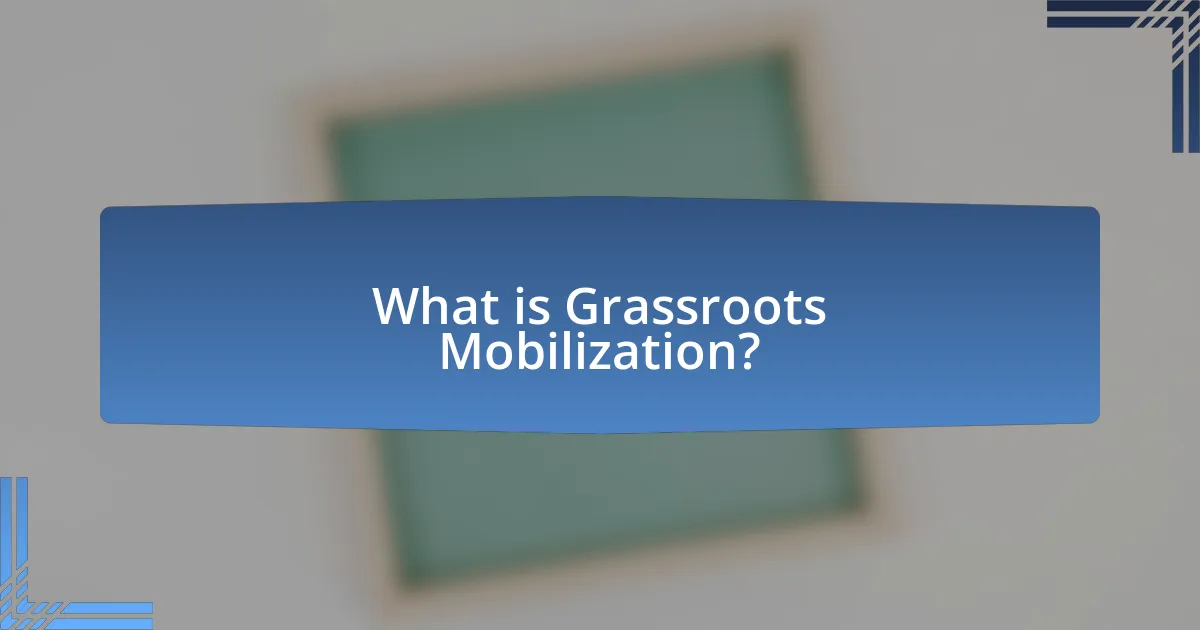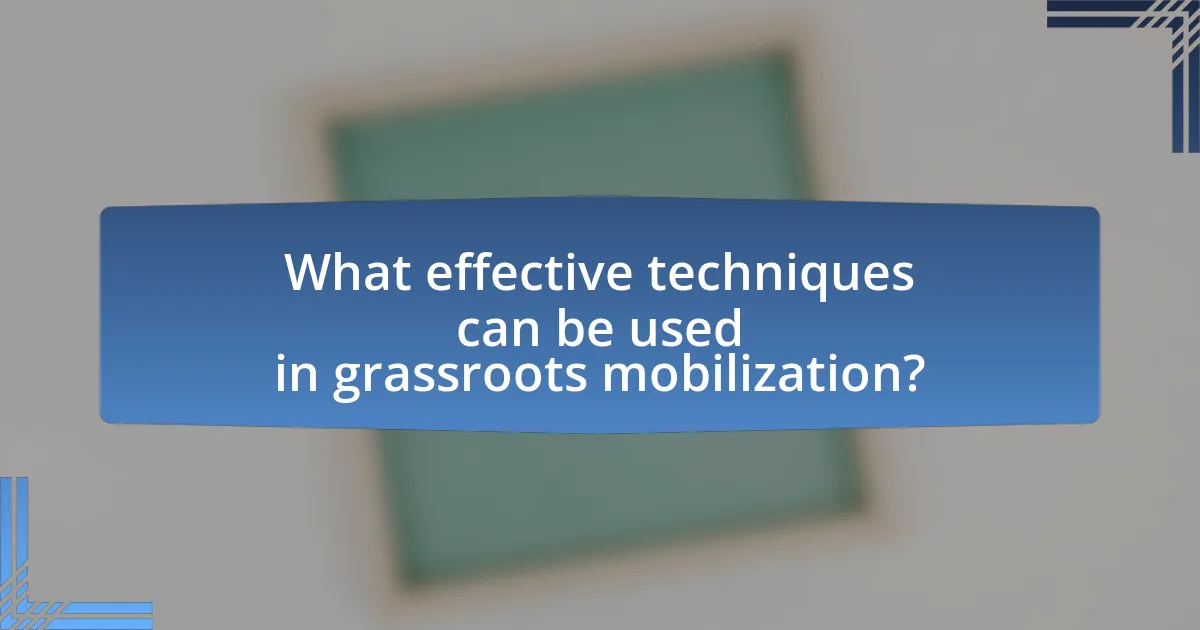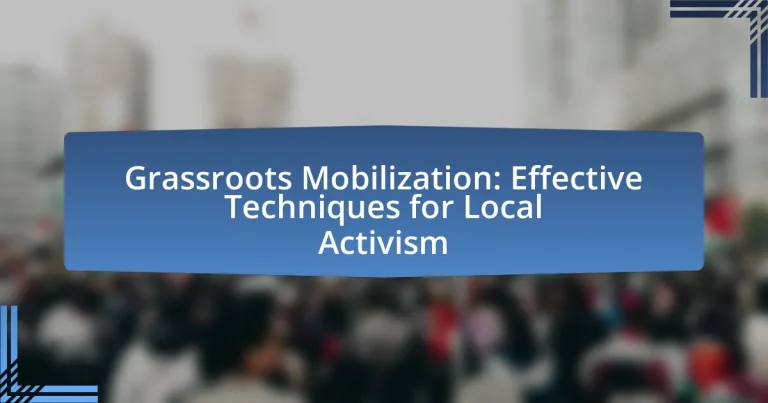Grassroots mobilization is the process of engaging individuals at the community level to advocate for social, political, or environmental change, emphasizing local participation and empowerment. This article explores the functioning of grassroots mobilization in local communities, highlighting key elements such as community engagement, clear messaging, and strategic organization. It discusses the importance of aligning mobilization efforts with community needs, the impact on policy change, and the empowerment of marginalized communities. Additionally, effective techniques for grassroots mobilization, including social media engagement and community events, are examined, along with challenges faced by grassroots organizers and best practices for enhancing effectiveness.

What is Grassroots Mobilization?
Grassroots mobilization is the process of engaging and organizing individuals at the community level to advocate for social, political, or environmental change. This approach relies on the collective efforts of ordinary people rather than established leaders or institutions, emphasizing local participation and empowerment. Evidence of its effectiveness can be seen in movements like the Civil Rights Movement in the United States, where grassroots efforts played a crucial role in achieving significant legislative changes, such as the Civil Rights Act of 1964.
How does grassroots mobilization function in local communities?
Grassroots mobilization functions in local communities by organizing individuals at the community level to advocate for social change and address local issues. This process typically involves building networks of engaged citizens who collaborate to identify common concerns, develop strategies, and implement actions that reflect their collective interests. For instance, community meetings, social media campaigns, and local events are often utilized to raise awareness and foster participation. Research indicates that grassroots movements can effectively influence policy decisions and drive community development, as seen in the success of initiatives like the Civil Rights Movement, which mobilized local citizens to challenge systemic injustices.
What are the key elements that drive grassroots mobilization?
The key elements that drive grassroots mobilization include community engagement, clear messaging, and strategic organization. Community engagement fosters a sense of belonging and encourages individuals to participate actively in local issues. Clear messaging ensures that the goals and objectives of the movement are easily understood, which helps to rally support and unify participants. Strategic organization involves planning and coordinating efforts effectively, utilizing resources efficiently, and establishing leadership roles to guide the movement. These elements are supported by historical examples, such as the Civil Rights Movement, where community involvement and organized efforts led to significant social change.
How do community needs influence grassroots mobilization efforts?
Community needs significantly influence grassroots mobilization efforts by shaping the priorities and strategies of local activists. When grassroots organizations assess the specific needs of their communities, such as access to healthcare, education, or housing, they can tailor their mobilization efforts to address these pressing issues directly. For instance, a study by the National Civic League found that grassroots movements that align their goals with community needs are more likely to achieve higher levels of engagement and support, as they resonate with the lived experiences of community members. This alignment fosters a sense of ownership and urgency among residents, motivating them to participate actively in advocacy and mobilization initiatives.
Why is grassroots mobilization important for local activism?
Grassroots mobilization is crucial for local activism because it empowers communities to collectively address issues that directly affect them. This approach fosters a sense of ownership and agency among community members, leading to increased participation and engagement in local decision-making processes. Research indicates that grassroots movements can effectively influence policy changes; for example, the 2018 youth-led March for Our Lives campaign successfully advocated for gun control reforms in various states, demonstrating the power of organized community action. By mobilizing individuals at the local level, grassroots efforts can create significant social change and amplify marginalized voices, making them essential for effective activism.
What impact does grassroots mobilization have on policy change?
Grassroots mobilization significantly influences policy change by amplifying the voices of local communities and driving collective action. This form of activism often leads to increased public awareness and pressure on policymakers, resulting in legislative reforms. For instance, the 2018 March for Our Lives movement, initiated by students advocating for gun control, successfully prompted lawmakers to consider stricter gun regulations, demonstrating how organized grassroots efforts can lead to tangible policy shifts. Additionally, research from the Stanford Social Innovation Review indicates that grassroots movements can effectively alter public opinion, which in turn influences political agendas and decision-making processes.
How does grassroots mobilization empower marginalized communities?
Grassroots mobilization empowers marginalized communities by providing them with a platform to voice their concerns and advocate for their rights. This form of community organizing fosters collective action, enabling individuals to unite around shared issues, thereby amplifying their influence in political and social spheres. For instance, movements like Black Lives Matter have demonstrated how grassroots efforts can lead to significant policy changes and increased awareness of systemic injustices. Research indicates that communities engaged in grassroots mobilization experience enhanced social cohesion and improved access to resources, which further strengthens their ability to effect change.

What effective techniques can be used in grassroots mobilization?
Effective techniques for grassroots mobilization include community organizing, social media engagement, and coalition building. Community organizing involves identifying local leaders and mobilizing residents around shared issues, which has been shown to increase participation and advocacy efforts. Social media engagement allows for rapid information dissemination and community connection, exemplified by movements like Black Lives Matter, which utilized platforms to organize protests and raise awareness. Coalition building fosters partnerships among various groups, enhancing resource sharing and collective impact, as seen in successful campaigns like the Fight for $15, which united labor unions and community organizations to advocate for higher minimum wages.
How can social media be leveraged for grassroots mobilization?
Social media can be leveraged for grassroots mobilization by facilitating rapid communication, organizing events, and building community engagement. Platforms like Facebook, Twitter, and Instagram allow activists to share information quickly, mobilize supporters for events, and create a sense of community around shared causes. For instance, the Arab Spring demonstrated how social media could effectively organize protests and disseminate information, leading to significant political change. Additionally, studies show that campaigns utilizing social media can increase participation rates by up to 50%, highlighting its effectiveness in mobilizing grassroots movements.
What platforms are most effective for local activism campaigns?
Social media platforms, particularly Facebook, Twitter, and Instagram, are the most effective for local activism campaigns. These platforms facilitate rapid information dissemination, community engagement, and mobilization efforts. For instance, Facebook allows for the creation of event pages and groups that can gather local supporters, while Twitter’s real-time updates enable activists to share urgent calls to action. Instagram’s visual storytelling capabilities help convey messages powerfully, attracting attention to local issues. According to a study by the Pew Research Center, 69% of adults in the U.S. use Facebook, making it a critical tool for reaching a broad audience in local communities.
How can storytelling enhance engagement in grassroots efforts?
Storytelling enhances engagement in grassroots efforts by creating emotional connections that resonate with individuals and communities. When grassroots organizations share compelling narratives, they can effectively illustrate the impact of their work, making complex issues more relatable and motivating people to take action. Research indicates that stories can increase empathy and understanding, which are crucial for mobilizing support; for instance, a study published in the journal “Psychological Science” found that narratives can significantly influence attitudes and behaviors by fostering a sense of shared experience. This emotional engagement not only attracts volunteers but also encourages donations and participation in campaigns, ultimately strengthening the grassroots movement.
What role do community events play in grassroots mobilization?
Community events serve as crucial platforms for grassroots mobilization by fostering engagement, building networks, and amplifying collective voices. These events create opportunities for individuals to connect, share experiences, and mobilize around common causes, thereby enhancing community solidarity. Research indicates that community gatherings can increase participation rates in local activism; for instance, a study by the National Civic League found that neighborhoods with regular community events saw a 30% increase in civic engagement compared to those without. This demonstrates that community events not only facilitate awareness but also empower individuals to take action collectively, reinforcing the effectiveness of grassroots movements.
How can organizing local events foster community involvement?
Organizing local events fosters community involvement by creating opportunities for residents to engage with one another and participate in shared activities. These events, such as festivals, clean-up days, or town hall meetings, encourage social interaction and build relationships among community members. Research indicates that communities with higher levels of social cohesion, often fostered through local events, experience increased civic participation and volunteerism, as evidenced by a study published in the Journal of Community Psychology, which found that neighborhoods with regular community events saw a 30% increase in volunteer activities. This engagement not only strengthens community ties but also empowers residents to take an active role in local decision-making processes.
What types of events are most effective for mobilizing support?
Community gatherings, rallies, and workshops are the most effective types of events for mobilizing support. These events foster direct engagement, allowing individuals to connect personally with the cause and each other. For instance, a study by the Stanford Social Innovation Review found that face-to-face interactions during community events significantly increase commitment levels among participants, leading to higher rates of ongoing support and activism. Additionally, events that incorporate storytelling and personal testimonies have been shown to resonate deeply, enhancing emotional connections and motivating action.

What challenges do grassroots mobilizers face?
Grassroots mobilizers face several significant challenges, including limited resources, lack of visibility, and resistance from established institutions. Limited resources hinder their ability to effectively organize events, reach wider audiences, and sustain long-term campaigns. For instance, a study by the National Democratic Institute found that grassroots organizations often operate on minimal budgets, which restricts their outreach capabilities. Lack of visibility can lead to difficulties in attracting volunteers and supporters, as many grassroots efforts struggle to gain media attention compared to larger organizations. Additionally, resistance from established institutions, such as local governments or corporations, can create obstacles in implementing initiatives or gaining necessary permits, as highlighted in research by the Center for Community Change, which documented numerous instances where grassroots efforts faced pushback from local authorities.
How can grassroots movements overcome funding limitations?
Grassroots movements can overcome funding limitations by leveraging community support and utilizing innovative fundraising strategies. These movements often rely on small donations from a large number of supporters, which can be facilitated through online crowdfunding platforms. For instance, campaigns on platforms like GoFundMe or Kickstarter have successfully raised significant amounts for various grassroots initiatives, demonstrating the effectiveness of collective small contributions. Additionally, grassroots movements can engage in local events, such as bake sales or community fairs, to raise funds while simultaneously increasing visibility and support within the community. Research indicates that grassroots organizations that build strong local networks and foster relationships with community members tend to have better access to resources and funding opportunities, as seen in the case of the Black Lives Matter movement, which effectively mobilized community resources to support its initiatives.
What strategies can be employed to secure resources for grassroots initiatives?
To secure resources for grassroots initiatives, organizations can employ strategies such as building community partnerships, leveraging social media for fundraising, and applying for grants. Community partnerships enhance resource sharing and increase visibility, as evidenced by successful collaborations between local nonprofits and businesses that have resulted in shared funding and resources. Utilizing social media platforms allows grassroots movements to reach wider audiences for crowdfunding campaigns, with platforms like GoFundMe reporting that over $9 billion has been raised for various causes since its inception. Additionally, applying for grants from foundations that support community development can provide substantial financial support; for instance, the Ford Foundation has awarded millions in grants to grassroots organizations focused on social justice. These strategies collectively enhance the ability of grassroots initiatives to secure necessary resources effectively.
How can grassroots movements navigate political opposition?
Grassroots movements can navigate political opposition by building coalitions, engaging in strategic communication, and leveraging community support. By forming alliances with other organizations, grassroots movements can amplify their voices and resources, making it harder for political opposition to dismiss their efforts. Strategic communication involves clearly articulating their goals and values to the public, which can help sway public opinion and create pressure on political entities. Additionally, grassroots movements can mobilize community support through local events and outreach, fostering a sense of solidarity and collective action that can counteract political resistance. Historical examples, such as the Civil Rights Movement, demonstrate how effective coalition-building and community engagement can lead to significant political change despite opposition.
What are common pitfalls in grassroots mobilization efforts?
Common pitfalls in grassroots mobilization efforts include lack of clear goals, insufficient community engagement, and inadequate resource allocation. Without clear goals, mobilization efforts can become unfocused, leading to wasted time and energy. Insufficient community engagement can result in a lack of trust and participation, as local voices may feel ignored or undervalued. Inadequate resource allocation, such as funding and volunteer support, can hinder the effectiveness of initiatives, limiting outreach and impact. These pitfalls are supported by studies indicating that successful grassroots movements often prioritize clear objectives, active community involvement, and strategic resource management to achieve their goals.
How can grassroots organizers avoid burnout among volunteers?
Grassroots organizers can avoid burnout among volunteers by implementing structured support systems and promoting a healthy work-life balance. Providing clear roles and responsibilities helps volunteers understand their contributions, reducing feelings of overwhelm. Regular check-ins and open communication foster a supportive environment, allowing volunteers to express concerns and share experiences. Additionally, recognizing and celebrating volunteer efforts can enhance motivation and commitment, as studies show that acknowledgment significantly boosts volunteer retention rates. By prioritizing these strategies, grassroots organizers can create a sustainable and engaged volunteer base.
What mistakes should be avoided when building a grassroots campaign?
When building a grassroots campaign, it is crucial to avoid underestimating the importance of community engagement. Failing to actively involve local stakeholders can lead to a lack of support and diminished campaign effectiveness. Research indicates that campaigns with strong community ties are 50% more likely to succeed in mobilizing voters compared to those that do not prioritize local involvement. Additionally, neglecting to clearly define campaign goals can result in confusion and misalignment among volunteers and supporters, ultimately hindering progress. A study by the Harvard Kennedy School found that campaigns with specific, measurable objectives are 70% more effective in achieving their desired outcomes. Lastly, overlooking the significance of consistent communication can alienate supporters and weaken the campaign’s message, as effective communication strategies have been shown to increase engagement by up to 60%.
What best practices can enhance grassroots mobilization effectiveness?
Best practices that can enhance grassroots mobilization effectiveness include building strong community relationships, utilizing social media for outreach, and organizing inclusive events. Strong community relationships foster trust and collaboration, which are essential for mobilization; for instance, studies show that communities with established networks are more likely to engage in collective action. Utilizing social media platforms allows for rapid dissemination of information and mobilization of supporters, as evidenced by the success of movements like Black Lives Matter, which effectively used Twitter and Facebook to organize protests. Organizing inclusive events ensures diverse participation, which can amplify voices and strengthen the movement’s impact, as demonstrated by the Women’s March, which brought together millions from various backgrounds to advocate for women’s rights.
How can grassroots organizers build strong coalitions for greater impact?
Grassroots organizers can build strong coalitions for greater impact by fostering inclusive relationships among diverse community stakeholders. This involves identifying shared goals, facilitating open communication, and creating a collaborative environment where all voices are valued. Research shows that coalitions with diverse membership are more effective; for instance, a study by the Community Tool Box highlights that inclusive coalitions can increase resource sharing and enhance problem-solving capabilities. By leveraging the strengths of various groups, grassroots organizers can amplify their collective influence and drive meaningful change.
What methods can be used to measure the success of grassroots initiatives?
To measure the success of grassroots initiatives, various methods can be employed, including surveys, community feedback, and quantitative metrics. Surveys can gauge participant satisfaction and engagement levels, providing direct insights into the initiative’s impact. Community feedback, gathered through forums or social media, offers qualitative data on public perception and effectiveness. Quantitative metrics, such as the number of participants, funds raised, or policy changes achieved, provide concrete evidence of success. For instance, a study by the Stanford Social Innovation Review highlights that initiatives demonstrating measurable outcomes, like increased voter turnout or community engagement, are often deemed successful.


